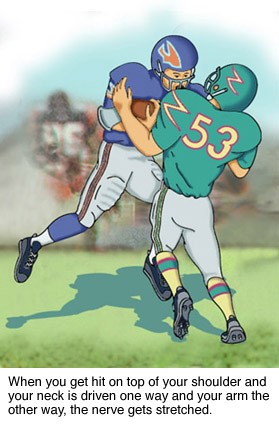Burners and Stingers
These articles are for general information only and are not medical advice. Full Disclaimer. All articles are compliments of the AAOS
Description
Burners and stingers are a common injury in contact or collision sports. The injury is named for the “stinging” or “burning” pain that radiates (spreads) from the shoulder to the hand. This can feel like an electric shot or “lightning bolt” down the arm and can be accompanied by a warm sensation.

Anatomy
Nerve roots exit the spinal canal of the neck and come together to form cords of nerves that ultimately provide sensation to all of the arm muscles. The nerve roots are named for the level at which they exit the spinal canal (i.e., C5 refers to a cervical nerve root 5 and exits the spinal cord at the 5th cervical spinal body). When a burner or stinger occurs, one potential area of injury is where the nerve root exits the spinal canal.
As the nerve roots move away from the spinal canal, they join to form larger bundles or cords. In the upper extremity, this is called the brachial plexus. All of the nerve supply to the arms runs through this plexus. This is also a potential site of injury that can cause a burner or stinger.
Incidence
This is a common injury in contact sports. In fact, up to 70 percent of all college football players report having experienced a burner or stinger during in their 4-year career.
Mechanism of Injury
Athletes who engage in contact sports are more likely to suffer this injury. The two most common sports for burners and stingers are:
- American football
- Wrestling
Tackling or blocking in football is the most common athletic activity causing a burner or stinger. Football defensive players and linemen therefore frequently suffer this injury (see Figure 1).
Another possible mechanism is a fall onto the head, such as in a wrestling takedown or a football tackle.
Symptoms
The injury is to the nerve supply of the upper limb, either at the neck or shoulder. In most cases, the injuries are temporary and symptoms resolve quickly. A “burning” or “electric” shock sensation is often felt. The arm may feel “dead” or numb immediately following the injury, and weakness is common. The symptoms most commonly occur in one arm only. Symptoms usually last seconds to minutes, but in 5 percent to 10 percent of cases, they can last hours, days, or even longer.
Diagnosis
An Orthopedist makes the diagnosis based on the history of injury and your symptoms. X-rays, magnetic resonance imaging (MRI), and other nerve studies are not usually needed. More extensive work-up is required if you have:
- Weakness lasting more than several days
- Neck pain
- Symptoms in both arms
- History of recurrent stingers/burners
Risk Factors/Prevention
In addition to the type of sport, another risk factor may be the size of the spinal canal. It has been suggested that athletes with recurrent stingers or burners may have a smaller spinal canal than players who do not suffer recurrent injury. This is a condition termed cervical or spinal stenosis.
Treatment Options: Nonsurgical
Treatment begins by removing the athlete from further injury. Athletes are not allowed to return to sports activity until their symptoms have been completely resolved. This can take a few minutes or several days. Athletes should never be allowed to return to sports if they have weakness or neck pain.
Although the injury gets better with time, the athlete may need to work with a trainer or therapist to regain strength and motion if the symptoms last for several days.
